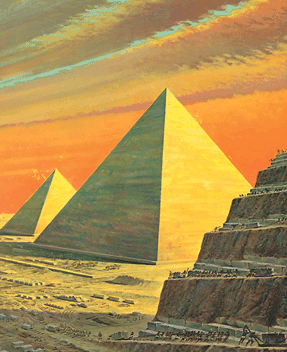May 1-7, 2014, Current Events Lesson Plan
Current Event:
A team of scientists recently discovered that the ancient Egyptians may have used a remarkably simple technique to move massive limestone blocks across the sand to build the pyramids. From about 2700 to 1700 B.C., the ancient Egyptians built 35 massive pyramids near the Nile River to protect the bodies of the pharaohs in the afterlife. The largest Egyptian Pyramid, the Great Pyramid of Khufu, was constructed from more than 2 million stone blocks that average 2.5 tons (2.3 metric tons) each. Over the years, scholars have proposed many theories to explain how the ancient Egyptians achieved this feat with only simple copper tools and manual labor. In a series of simple experiments, the scientists demonstrated that adding a small amount of water to sand greatly reduces friction, making it much easier to slide an object–even a very heavy object–over it. In sand with just the right amount of dampness, water binds the grains together through capillary action, which increases the stiffness of the sand. The scientists found that wet sand could cut the force required to drag a sled weighing several tons by about half.

The pyramids of Egypt at Giza are the best preserved of the Seven Wonders of the Ancient World. They still attract many visitors to Giza, just outside the present-day city of Cairo. (World Book illustration by Birney Lettick)
Objective:
Pyramids are large structures with square bases and four smooth, triangular-shaped sides that come to a point at the top. Several ancient peoples used pyramids as tombs or temples. The most famous pyramids are those built about 4,500 years ago as tombs for Egyptian kings. Imhotep, a great architect and statesman, built the first known pyramid about 2650 B.C. The pyramid rose in a series of giant steps, or terraces, and is called the Step Pyramid. This pyramid still stands at the site of the ancient city of Memphis, near Cairo. The first smooth-sided pyramid was built about 2600 B.C. It still stands at Medum. Between about 2600 and 2500 B.C., 10 pyramids, including the Great Pyramid of Khufu, were built at Giza. Thieves broke into most of the pyramids, stole the gold, and sometimes destroyed the bodies. Later Egyptian kings stopped using pyramids, and built secret tombs in cliffs. But some kings of the Kushite kingdom in Nubia, south of Egypt, built pyramids long after they were no longer used in Egypt. The Behind the Headlines news story and related World Book articles explore pyramids and other facets of ancient Egypt.
Words to know:
• Ancient Egypt
• Capillary action
• Egypt
• Giza
• Imhotep
• Khufu
• Nile River
• Pharaohs
• Pyramids
• Seven Wonders of the Ancient World
Discussion Topics:
1. Ask your students what they know about Egypt. (Students might say that Egypt is in the Middle East; Cairo is the country’s capital and largest city; the Nile River flows through Egypt.)
2. Ask your students what they know about ancient Egypt. (Students might say that ancient Egypt depended on the Nile River; the ancient Egyptians worshipped many gods and goddesses; the ancient Egyptians used hieroglyphics to write; the ancient Egyptians mummified corpses to prevent them from decaying.)
3. Archaeologists work in many places including Egypt, Greece, the Middle East, North America, and even underwater. Ask your students, “If you could be an archaeologist, where would you want to work? Why?”
4. Ask your student to debate: “It is important to learn about ancient civilizations and cultures in school.”
5. Ask your students to use World Book’s Timelines feature to view or add to the History of Ancient Egypt timeline. (Students may wish to also refer to the “History” section of World Book’s Ancient Egypt article for help.)


